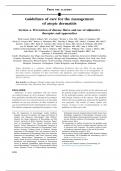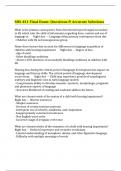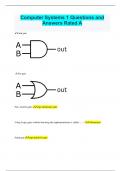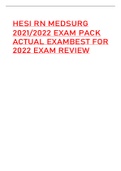FROM THE ACADEMY
Guidelines of care for the management
of atopic dermatitis
Section 4. Prevention of disease flares and use of adjunctive
therapies and approaches
Work Group: Robert Sidbury, MD (Co-chair),a Wynnis L. Tom, MD,b James N. Bergman, MD,c
Kevin D. Cooper, MD,d Robert A. Silverman, MD,e Timothy G. Berger, MD,f Sarah L. Chamlin, MD, MSCI,g
David E. Cohen, MD,h Kelly M. Cordoro, MD,f Dawn M. Davis, MD,i Steven R. Feldman, MD, PhD,j
Jon M. Hanifin, MD,k Alfons Krol, MD,k David J. Margolis, MD, PhD,l Amy S. Paller, MD,g
Kathryn Schwarzenberger, MD,m Eric L. Simpson, MD,k Hywel C. Williams, DSc,n Craig A. Elmets, MD,o
Julie Block, BA,p Christopher G. Harrod, MS,q Wendy Smith Begolka, MBS,q and
Lawrence F. Eichenfield, MD (Co-chair)b
Seattle, Washington; San Diego, San Francisco, and San Rafael, California; Vancouver, British Columbia,
Canada; Cleveland, Ohio; Fairfax, Virginia; Chicago and Schaumburg, Illinois; New York, New York;
Rochester, Minnesota; Winston-Salem, North Carolina; Portland, Oregon; Philadelphia, Pennsylvania;
Memphis, Tennessee; Nottingham, United Kingdom; and Birmingham, Alabama
Atopic dermatitis is a common, chronic inflammatory dermatosis that can affect all age groups.
This evidence-based guideline addresses important clinical questions that arise in its management. In
this final section, treatments for flare prevention and adjunctive and complementary therapies and
approaches are reviewed. Suggestions on use are given based on available evidence. ( J Am Acad Dermatol
2014;71:1218-33.)
Key words: aeroallergens; allergy testing; atopic dermatitis; calcineurin inhibitors; complementary therapy;
corticosteroids; diet; education; flare; food allergy; topicals.
DISCLAIMER specific therapy must be made by the physician and
Adherence to these guidelines will not ensure the patient in light of all the circumstances presented
successful treatment in every situation. Furthermore, by the individual patient, and the known variability
these guidelines should not be interpreted as setting a and biologic behavior of the disease. This guideline
standard of care or be deemed inclusive of all proper reflects the best available data at the time the guideline
methods of care nor exclusive of other methods of was prepared. The results of future studies may
care reasonably directed to obtaining the same results. require revisions to the recommendations in this
The ultimate judgment regarding the propriety of any guideline to reflect new data.
From the Department of Dermatology,a Seattle Children’s Nottingham University Hospitals National Health Service Trust,
Hospital; University of California, San Diego and Division of Nottingham; Department of Dermatology,o University of Ala-
Pediatric and Adolescent Dermatology,b Rady Children’s bama at Birmingham; National Eczema Association,p San Rafael;
Hospital, San Diego; Department of Dermatology and Skin and the American Academy of Dermatology,q Schaumburg.
Science,c University of British Columbia, Vancouver; Depart- Funding sources: None.
ment of Dermatology,d Case Western University; private The management of conflict of interest for this guideline series
practice,e Fairfax; Department of Dermatology,f University of complies with the Council of Medical Specialty Societies’ Code
California San Francisco; Department of Dermatology,g North- of Interactions with Companies. The authors’ conflict of inter-
western University Feinberg School of Medicine, Chicago; est/disclosure statements appear at the end of this article.
Department of Dermatology,h New York University School of Accepted for publication August 22, 2014.
Medicine; Department of Dermatology,i Mayo Clinic, Rochester; Reprint requests: Wendy Smith Begolka, MBS, American Academy
Department of Dermatology,j Wake Forest University Health of Dermatology, 930 E Woodfield Rd, Schaumburg, IL 60173.
Sciences, Winston-Salem; Department of Dermatology,k E-mail: wsmithbegolka@aad.org.
Oregon Health & Science University, Portland; Department of Published online September 25, 2014.
Biostatistics and Epidemiology,l University of Pennsylvania 0190-9622/$36.00
School of Medicine, Philadelphia; Kaplan-Amonette Depart- Ó 2014 by the American Academy of Dermatology, Inc.
ment of Dermatology,m University of Tennessee Health Science http://dx.doi.org/10.1016/j.jaad.2014.08.038
Center, Memphis; Centre of Evidence-Based Dermatology,n
1218
,J AM ACAD DERMATOL Sidbury et al 1219
VOLUME 71, NUMBER 6
by the work group to be of importance to clinical
Abbreviations used: care. Searches were prospectively limited to publica-
AAD: American Academy of Dermatology tions in the English language. Medical Subject
ACD: allergic contact dermatitis Headings terms used in various combinations in
AD: atopic dermatitis
APT: atopy patch tests the literature search included: atopic dermatitis,
HDM: house dust mite atopic eczema, surveillance, long-term management,
IgE: immunoglobulin E short-term management, short-term care, long-term
ICD: irritant contact dermatitis
NIAID: National Institute of Allergy and Infectious care, flare progression, relapse, patient follow-up,
Disease patient compliance, contact allergen, contact allergy
SCORAD: SCORing Atopic Dermatitis screen, contact allergy test, desensitization, allergen
SPT: skin prick tests
TCI: topical calcineurin inhibitors antibody, antiallergen, antibody, dust mites, environ-
TCM: traditional Chinese medicine mental, food allergy, irritant avoidance, detergent,
TCS: topical corticosteroids clothing, diet, supplement, food introduction, oil,
RCT: randomized controlled trial
pyridoxine, vitamin, zinc, education, complemen-
tary, alternative, herb, supplement, homeopathy,
massage, acupuncture, and Chinese medicine.
SCOPE A total of 2062 abstracts were initially assessed for
This guideline addresses the treatment of pedia- possible inclusion. After the removal of duplicate
tric and adult atopic dermatitis (AD; atopic eczema) data, 287 were retained for final review based on
of all severities. The treatment of other forms of relevancy and the highest level of available evidence
eczematous dermatitis is outside the scope of this for the outlined clinical questions. Evidence tables
document. Recommendations on AD management were generated for these studies and used by the
are subdivided into 4 sections given the significant work group in developing recommendations. The
breadth of the topic, and to update and expand on Academy’s previously published guidelines on AD
the clinical information and recommendations were evaluated, as were other current published
previously published in 2004. This document is the guidelines on AD.2-5
final in the series of 4 publications and discusses the The available evidence was evaluated using a uni-
management and control of AD flares using topical fied system called the Strength of Recommendation
modalities and the utility and timing of allergen Taxonomy (SORT) developed by editors of the US
testing and avoidance. Also discussed is the use family medicine and primary care journals (ie,
of adjunctive therapies and approaches, such as American Family Physician, Family Medicine,
environmental, dietary, and educational interven- Journal of Family Practice, and BMJ USA).6 Evidence
tions, in addition to complementary therapies. was graded using a 3-point scale based on the quality of
methodology (eg, randomized control trial, case
METHOD
control, prospective/retrospective cohort, case series,
A work group of recognized AD experts was
etc) and the overall focus of the study (ie, diagnosis,
convened to determine the audience and scope of
treatment/prevention/screening, or prognosis) as
the guideline and to identify important clinical
follows:
questions in the management of flare progression
I. Good-quality patient-oriented evidence (ie,
and the use of adjunctive therapies and approaches
evidence measuring outcomes that matter to
(Table I). Work group members completed a
patients: morbidity, mortality, symptom improve-
disclosure of interests that was updated and
ment, cost reduction, and quality of life).
reviewed for potential relevant conflicts of interest
II. Limited-quality patient-oriented evidence.
throughout guideline development. If a potential
III. Other evidence, including consensus guidelines,
conflict was noted, the work group member recused
opinion, case studies, or disease-oriented
him or herself from discussion and drafting of
evidence (ie, evidence measuring intermediate,
recommendations pertinent to the topic area of the
physiologic, or surrogate end points that may or
disclosed interest.
may not reflect improvements in patient
An evidence-based model was used, and evidence
outcomes).
was obtained using a search of the PubMed and the
Global Resources for Eczema Trials1 databases from Clinical recommendations were developed based
November 2003 through November 2012 for clinical on the best available evidence tabled in the
questions addressed in the previous version of this guideline. These are ranked as follows:
guideline published in 2004, and from 1960 to 2012 A. Recommendation based on consistent and
for all newly identified clinical questions determined good-quality patient-oriented evidence.
, 1220 Sidbury et al J AM ACAD DERMATOL
DECEMBER 2014
B. Recommendation based on inconsistent or The strategy required to minimize recurrence
limited-quality patient-oriented evidence. varies depending on the individual and his or her
C. Recommendation based on consensus, opinion, frequency, severity, and sites of disease. Moisturizers
case studies, or disease-oriented evidence. should be an integral part of the maintenance
treatment plan given their low risk and ability to
In those situations where documented evidence-
improve skin hydration; some may also address the
based data are not available, we have used expert
negative effects of epidermal barrier dysfunction.9-11
opinion to generate our clinical recommendations.
Two studies have shown that daily moisturizer use
This guideline has been developed in accordance
can lengthen the time to first flare, compared to no
with the American Academy of Dermatology (AAD)/ treatment.12,13 In some cases, this strategy may
AAD Association Administrative Regulations
be adequate and antiinflammatory therapies
for Evidence-based Clinical Practice Guidelines
reinstituted only when new eczematous lesions are
(version approved May 2010), which includes the
noted.13-15 This is considered a reactive approach to
opportunity for review and comment by the entire
long-term management.
AAD membership and final review and approval by
However, some individuals benefit from a more
the AAD Board of Directors.7 This guideline will be
proactive method, whereby topical corticosteroids
considered current for a period of 5 years from the
(TCS) or topical calcineurin inhibitors (TCI) are
date of publication, unless reaffirmed, updated, or applied to both previously and newly involved skin
retired at or before that time.
on a scheduled, intermittent basis and moisturizers
used on all areas. Five randomized controlled
DEFINITION trials (RCTs) with up to 4 weeks of acute disease
AD is a chronic, pruritic inflammatory skin disease control followed by twice weekly application of a
that occurs most frequently in children, but also midpotency TCS (fluticasone propionate or
affects many adults. It follows a relapsing course. methylprednisolone aceponate) for 16 to 20 weeks
AD is often associated with elevated serum demonstrated a reduction in the risk of flare
immunoglobulin (IgE) levels and a personal or development and lengthening of the time to relapse
family history of type I allergies, allergic rhinitis, or first flare, relative to vehicle.14,16-19 A metaanalysis
and asthma. Atopic eczema is synonymous with AD. of the fluticasone studies found a substantial
magnitude of benefit (pooled relative risk of flares
INTRODUCTION of 0.46 [95% confidence interval {CI}, 0.38-0.55] vs
The often protracted nature of AD necessitates vehicle).20 Two to 3 times weekly application of
setting several long-term treatment goals: the topical tacrolimus (0.03% in children, 0.1% in adults)
prevention of continued outbreaks, the management to previously affected sites revealed similar benefits
of comorbidities and secondary complications that over 40 to 52 weeks of use (3 RCTs, pooled relative
arise, and minimizing adverse effects while trying to risk of flares of 0.78 [95% CI, 0.60-1.00]).20-23 This
maximize positive outcomes. Clinical studies method of TCI use also led to a decrease in the
focused on more extended disease control have number of flares and an increase in days free of
increased in recent years. Additional data regarding topical antiinflammatory use compared to vehicle.
allergic comorbidities support the need for testing or The recommendation for flare prevention is in
intervention, but only in particular instances. In Table II and level of evidence in Table III. Further
addition to the topical and systemic approaches supporting proactive treatment are histologic
reviewed in earlier parts of these guidelines, multiple findings of a persistently abnormal epidermal barrier
adjunctive and complementary modalities have been and residual low-grade inflammation at previously
tried, with varying degrees of success. Discussion of involved sites, even when there is little clinical
these measures and suggestions on their use are evidence of involvement.24
provided based on the available evidence. The proactive application of TCS or TCIs appears
to be an effective strategy for AD flare prevention,
PREVENTION OF DISEASE FLARES but there remain unanswered questions with use.
AD is characterized by periods of acute worsening Because there are no studies directly comparing the
(‘‘flares’’) alternating with periods of relative 2 classes of topical therapy used in this manner, it is
quiescence after treatment. The precise definition not clear if 1 intervention is more effective, although
of a flare, however, differs across studies and is an a metaanalysis of the vehicle-controlled trials
ongoing area of research.8 For pragmatic reasons, suggested that topical fluticasone is superior to
the definitions of flare from each published paper tacrolimus in preventing relapses.20 Skin atrophy
have been accepted for this guideline. was not noted with scheduled, intermittent TCS use,








